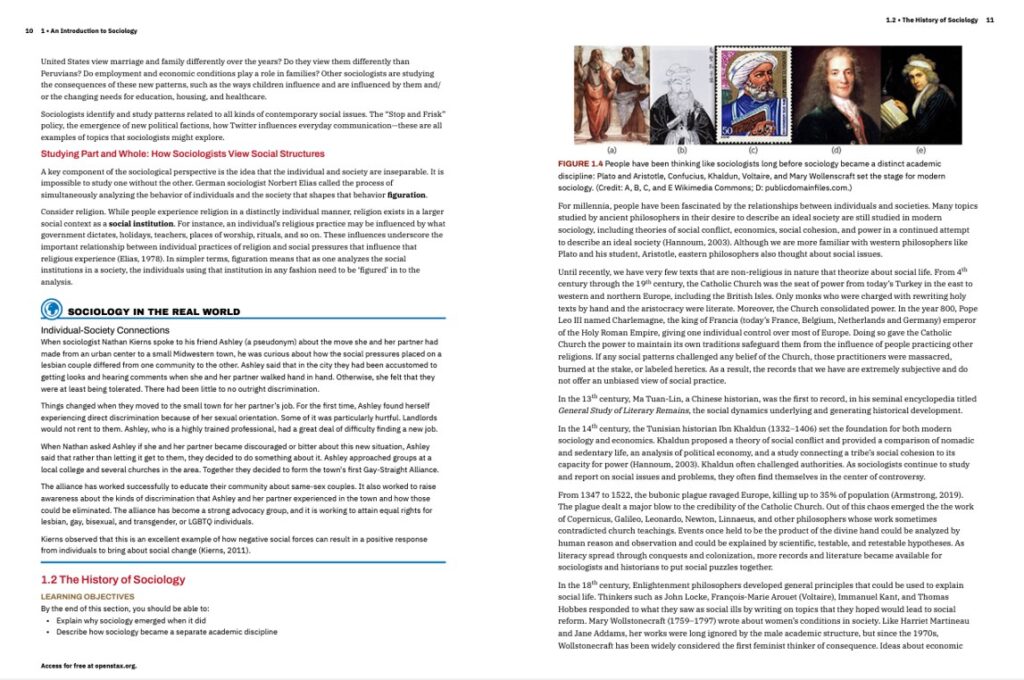The first overarching theme emerging from both the quantitative and qualitative analyses is that the standard textbooks enhance their attractiveness by including more visualizations, such as photographs, graphics, illustrations, colors, and varying page layouts compared to the OER counterparts. There is a simple explanation behind this observation: the standard textbooks included in the sample are published by big publishers, who have bigger budgets for these visual aspects and higher price tags. For example, looking at the quantitative coding for both types of textbooks, traditional ones exceed their OER counterparts in the number of both photographic and non-photographic visuals. In particular for OER texts, the average number of photographs in a sampled textbook chapter is 7 and non-photographic visuals is 1.79. Meanwhile, the traditional textbooks have, on average, 11.77 photographic and 2.23 non-photographic visuals each. Obtaining the rights to reproduce a photograph in a textbook can be very costly if the photos chosen do not have creative commons licenses, which works out for the big publishers since they have more capital to spend on this matter. One can also expect that there are a plethora of copyrighted photographs available out there compared to ones with creative commons licensing. Additionally, illustrations and line drawings cost money, especially if they are tailored to the textbooks. Hence, the bigger the budgets the publishers have, the more photographic and non-photographic visuals, such as illustrations, can be included in the texts. It is notable that these costly expenses all go toward the higher price tags we see in standard commercial textbooks.
A similar argument can be made for the color and page layout usage between the two types of textbooks. From the qualitative coding, it is evident that the traditional textbooks generally have more complex page formatting that utilizes space on a page in a more creative way than the majority of the OER textbooks. Again, using more creative and complex page layouts is possible if one has the capital for a visualization team. The same can also be said for the use of colors. In the examples below, the traditional textbook uses two distinct colors (blue and orange) for the two levels of headings, another one (red) for the vocabulary in the box, and two additional colors (blue and green) for the different types of information boxes, totaling to five colors. On the other hand, we can only see one color (blue) in the OER textbook example, with most of the text appearing in black and the hyperlinks appearing in blue.
Drag the slider in the middle left or right to see the differences in color usage and page layouts.
Looking at the layouts between the two textbooks, there are also discernible differences. The standard textbook example uses two columns of texts per page, mixed with a small vocabulary box, a colorful graph, and an image that is well-positioned among the text. On the other hand, the OER example has one column of text per page and the sizing of the photograph and table do not differ much from the width of the text column.
So, does this mean the market does not have a comparable OER option? In fact, there is something comparable as an OER textbook. The text I am referring to is the Introduction of Sociology published by OpenStax (2021). Within the OER market, OpenStax has been at the forefront, pioneering free, open-access, college-level resources for a variety of disciplines. What sets OpenStax’s OER texts apart from other OER texts is the amount of grants they receive (OpenStax.org 2022). The examples below are two pages from OpenStax’s (2021) OER textbook for introductory Sociology. They use three colors (red, brown, and blue) to differentiate the three levels of heading. They also use differing font sizes to highlight the different heading levels. Moreover, this text is also conscious of the placement of the visuals. Although they are not as colorful, the OpenStax (2021) OER text shows more effort in formatting, coloring, and choosing layouts than more typical OER texts in the sample.
